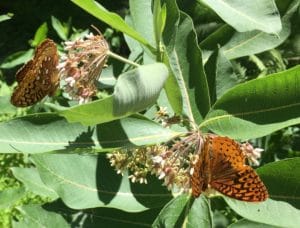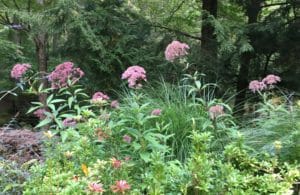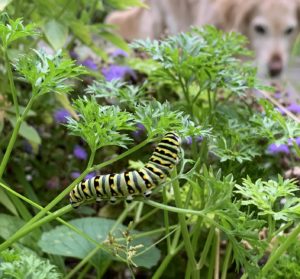Hello Fellow Readers, We spoke a few weeks back about Sarah’s mile-a-minute weedy dilemma in Hope, NJ. She proudly sent photos of the clear-out of her front foundation garden, poised to be a butterfly garden. Sarah asked if there was a list of native deer-resistant butterfly plants she could consider. Yes indeed!
Native plants are often easier to grow, and more importantly, insects and animals rely on them, especially birds. For example, an oak tree can support over 500 species of moths and butterflies, amongst other insects. In contrast, a Bradford Pear (a common ornamental non-native) supports fewer than 100. The more insects, the more bird food available.
Cross-referencing Butterfly Plants with Deer Resistant Native Plants.
The Native Plant Society of NJ publishes Host Plants, which provide a habitat for butterfly larvae (caterpillars) that they feed on and indicate which species they attract. They also publish a list of Native Nectar Plants. These plants are native to Pennsylvania and many other areas (check with your local native plant society).
In the spirit of Sarah’s request, I’ve cross-referenced the Butterfly Plants with Deer Resistant Native Plants and came up with the following beauties.
Tree hosts include Birches, Eastern Red Cedar, American Holly, Oaks, Pines, Paw Paw, and Redbud. Once leaves rise above browsing level, other native host trees like Sassafras, Tulip Trees (Yellow Poplar), Hickories, and Walnuts are deer-resistant too.
Shrub hosts include Dogwoods, Meadowsweets, Arrowood, and Black haw Viburnum (V. dentantum and prunifolium), Chokeberries, NJ Tea, aka Redroot, and Spicebush. The latter two are nectar plants as well. Host native grasses and sedges include Little Bluestem, Panic Grasses (Panicum), and Sedges (Carex).
Deer-Resistant Native Perennials for Butterflies
There are many deer-resistant native nectar plants such as Beebalm, aka Bergamot (Monarda), Blazing Stars (Liatrus), Coneflowers, Goldenrod, Hyssops, Ironweed, Tickseed (Coreopsis), Phlox, and Sneezeweed. My very favorite is in its fall glory now—Joe Pye Weed (Eupatorium) with its mop-like burst of pinkish mauve fluff rising four to seven feet high.
Perhaps you are wondering why Butterfly Bush (Buddleia) is not on the list. Not only is it not native, but caterpillars don’t feed on the plant, and it’s considered invasive by many.
“To have butterflies, we need to make butterflies.”
Douglas Tallamy, the author of the must-read Bringing Nature Home, writes, “To have butterflies, we need to make butterflies.” He cites milkweeds (Asclepias) as the must-have host and nectar plants.
By planting an assortment such as butterfly weed (A. turerosa), common milkweed (A. syriaca), and swamp milkweed (A. incarnata), you’ll attract many species of butterflies from June through September. “Moreover, along with the floral show, you’ll get brand new butterflies,” writes Tallamy.
Fall is ideal for planting most trees and shrubs and many perennials other than grasses and sedges. And bargains at our local nurseries abound. So, dig in and help make more butterflies. Sorry Deer, we’ll stick with deer-resistant plants. Garden Dilemmas? AskMaryStone@gmail.com
In previous columns, you’ll enjoy A Butterfly Garden of Growth and Late Summer Butterfly Magnets.
There’s more to the story in the Garden Dilemmas Podcast:
Column updated 5/7/23





